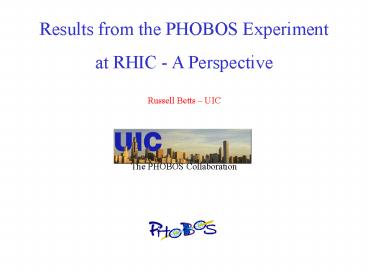Results from the PHOBOS Experiment - PowerPoint PPT Presentation
1 / 43
Title:
Results from the PHOBOS Experiment
Description:
The Data and Analysis. The Nature of the Matter formed in AA Collisions ... NIM A 499 (2003) 603. Octagon. TOF. SpecTrig. T0 counter. 44-p Multiplicity Detector ... – PowerPoint PPT presentation
Number of Views:47
Avg rating:3.0/5.0
Title: Results from the PHOBOS Experiment
1
Results from the PHOBOS Experiment at RHIC - A
Perspective Russell Betts UIC for The PHOBOS
Collaboration
2
(No Transcript)
3
Outline of the Talk
- The PHOBOS Experiment
- The Data and Analysis
- The Nature of the Matter formed in AA Collisions
- Discovery of Simple Scaling Rules
4
The PHOBOS Experiment (2004)
- 44-p Multiplicity Detector
- MMagnetic Spectrometer TOF
T0 counter
SpecTrig
TOF
Paddle Trigger Counter
Octagon
Spectrometer
NIM A 499 (2003) 603
5
Multiplicity and Trigger Detectors
Octagon
Paddle Trigger Counter
ZDC
Ring Counter
6
Counting Particles
Bulk of Particles pTlt1GeV
7
Vertex Tracklets (I)
Tracklets are two point tracks that are
constrained by the event vertex.
dh h1 h2 df f1 f2
Vertex Detector Event Display
dh lt 0.04 df lt 0.3
8
Vertex Tracklets (II)
All Pairs of Hits
9
Hit Counting (I)
Octagon, Ring and Vertex Detectors
(unrolled) Count Hits or Deposited Energy
10
Discriminating Background
DE vs. h in the Octagon
Monte Carlo
Data
DE (MIP)
h
h
Not from Vertex
Si
From Vertex
11
Measure the Occupancy
Method Assume Poisson statistics
Nnumber of tracks/pad m mean number of
tracks/pad
The numbers of empty and occupied pads determine
the occupancy as a function of h,b
12
Energy Loss ? Multiplicity
300 mm Si
Energy deposited in ith pad (truncated) corrected
for angle of incidence
Mean energy loss for one particle traversing pad
RATIO OF TOTAL TRACKS TO PRIMARY TRACKS
0.30 - 0.40
Measured S/N 10 - 20 ltlt Landau Width Use
Non-Hit pads - for Common-Mode Noise
Suppression M 240 15 5 CMN for one sensor
(120 channels) at h 0
13
Elliptic Flow
Fourier decomposition of the Azimuthal
Multiplicity Distribution
dN/d(f -YR ) N0 (1 2V1cos (f-YR) 2V2cos
(2(f-YR) ... )
Directed flow
Elliptic flow
(reaction plane YR)
View along beamline
V2 lt cos (2(f-Y2)) gt / ( ltcos(2(Y2a
- Y2b))gt )1/2
14
Centrality Determination
15
NPart and NColl (AuAu)
Paddle Mean
NPart
16
NPart and Ncoll (dAu)
HIJING Simulation
Counts
dN/dh
Pseudorapidity
Multiplicity Distribution
- Glauber Calculation
- Hijing 1.383
- Hulthen w.f.
- 41mb inelastic cross-section
- Full GEANT Simulation
17
The Data
dAu
Also pp at 200 GeV AuAu at 62.4 GeV/u Spectra
Talk by Adam Trzupek
AuAu
18
Particle Density near Mid-Rapidity
On the low side of nearly all predictions
19
Energy per Unit Volume
Number of Particles Produced at y0
ltEgt 0.7 GeV
dNch/dh
Therefore total energy released in h lt 1 is
2000GeV
Energy of Collision
Relevant Initial Volume ?R2 ? ( 1 fm) ? 2
Initially released Energy per Unit Volume ? 5
GeV/fm3 Note Energy Density inside Proton 0.5
GeV/fm3
Data from PRL 85, 3100 (2000) PRL 88, 22302
(2002) PRL 91, 052303 (2003)
arXivnucl-ex/0405027
20
The Energy Density is High (3-5
GeV/fm3)andMuch Larger than Inside a
HadronA Description in Terms of Hadronic
Degrees of Freedom is Inappropriate
21
Baryon Free at Mid-Rapidity
PRC 67, 021901R (2003)
22
Evidence from Flow
Approaches Hydro Limit
PRL,89, 222301 (2002) Nucl. Phys.A715, 611c (2003)
23
Evidence from Low pT Particles
In a large volume, weakly interacting system we
would expect the development of particles with
long wavelength
PHOBOS PHENIX
arXivnucl-ex/0401006
24
Suppression of High-pT Particles
PHOBOS dAu 200 GeV
AuAu 0-6 200 GeV
PRL 91, 072302 (2003)
25
The System is Strongly InteractingatEarly Times
(?2fm/c)
26
No Plateau in Rapidity Distributions
Plateau in Pseudorapidity Distributions is
Misleading Rapidity Distributions of Pions are
Gaussian
PRL 91, 052303 (2003) arXivnucl-ex/0403050
27
No Boost-Invariant Plateau for v2
PHOBOS Preliminary v2200
PHOBOS v2130
PRL 89, 222301 (2002)
28
Limiting Fragmentation in pp
29
Scaling Limiting Fragmentation
PRL 91, 052303 (2003)
30
A Rest Frame
p or d Rest Frame
arXivnucl-ex/0403033
31
Dependence of v2 on ?sNN and ?
Submitted to PRL arXivnucl-ex 0406021
32
Limiting Fragmentation in v2
Submitted to PRL arXivnucl-ex 0406021
33
Longitudinal Scaling
- Originally expected boost-invariance in
mid-rapidity region not observed. - Scaling in fragmentation region seen in AuAu,
dAu and (previously) in pp and pA
34
Connection between Central and Fragmentation
Regions
PHOBOS
PRL 91, 052303 (2003)
Nucl.Phys. A715 (2003) 65-74
35
How to Compare AuAu, pp, and dAu
In pp collisions, on average, approximately half
the energy goes into the leading baryon
A.Brenner et al.Phys.Rev.D26 (1982)1497l
arXivnucl-ex/0301017 arXivnucl-ex/0403033
AuAu higher than pp and dAu. But..
36
Universal Curve for Nch vs ?(s)
When pp corrected for leading baryon
37
Npart scaling for pA, KA, pA, dA, AA 10 GeV to
200 GeV Npart from 2 to 350
Preliminary
pp chosen to have the same available energy
Phobos and E178 data
E178 J.E.Elias et al., Phys.Rev.D22(1980) 13
arXivnucl-ex/0403033
38
NPart Scaling of Total Particle Production
Independent of Nature of Collision System
39
Factorization of Energy and Centrality Dependence
PRC 70 (2004) 021902R
Where are the Minijets?
40
Centrality Dependence of dAu
arXivnucl-ex/0403033
41
Factorization into Geometric and Energy Parts
SAME SEEN IN pA AT ENERGIES 50-200 GeV
arXivnucl-ex/0403033
42
Energy and Geometry Factorize Independent of pT
62.4 GeV 200 GeV
PHOBOS
arXivnucl-ex/0405003
43
Summary and Conclusions
- High Energy Density Strongly Interacting Matter
Description in Terms of Simple Hadronic Degrees
of Freedom Inappropriate. ( No Direct Evidence of
Color Deconfinement or Partonic d.o.f) - The Matter is Strongly Interacting Not the
Weakly Coupled QGP Originally Envisioned - Simple Scaling Rules Unite the Data. Suggest
Global Constraints or Universality































